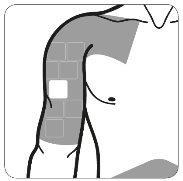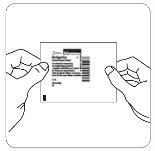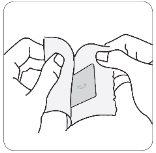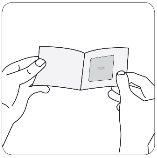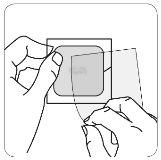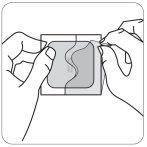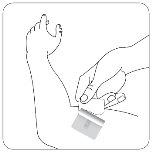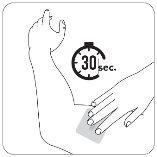
DARIANTE 2 mg/24 hours TRANSDERMAL PATCHES

How to use DARIANTE 2 mg/24 hours TRANSDERMAL PATCHES
Introduction
Package Leaflet: Information for the User
Dariante 2 mg/24 h Transdermal PatchesEFG
rotigotine
Read all of this leaflet carefully before you start using this medicine because it contains important information for you.
- Keep this leaflet, you may need to read it again.
- If you have any further questions, ask your doctor or pharmacist.
- This medicine has been prescribed for you only. Do not pass it on to others. It may harm them, even if their signs of illness are the same as yours.
- If you get any side effects, talk to your doctor or pharmacist. This includes any possible side effects not listed in this leaflet. See section 4.
Contents of the pack
- What is Dariante and what is it used for
- What you need to know before you use Dariante
- How to use Dariante
- Possible side effects
- Storing Dariante
- Contents of the pack and other information
1. What is Dariante and what is it used for
What is Dariante
Dariante contains the active substance rotigotine.
It belongs to a group of medicines known as “dopamine agonists”. Dopamine is an important messenger in the brain for movement.
What is Dariante used for
Dariante is used in adults to treat the signs and symptoms of:
- Parkinson's disease- Dariante can be used alone or with another medicine called levodopa.
- Restless Legs Syndrome(RLS) – this syndrome can be associated with discomfort in the legs or arms, a need to move, sleep disturbances and a feeling of tiredness or sleepiness during the day. Treatment with Dariante reduces or decreases the duration of these symptoms.
2. What you need to know before you use Dariante
Do not use Dariante if:
- you are allergicto rotigotineor any of the other ingredientsof this medicine (listed in section 6)
- you are going to have a magnetic resonance imaging(MRI) scan (diagnostic images of the inside of the body, created using magnetic energy instead of X-ray energy)
- you need a cardioversion(specific treatment for heart rhythm disturbances).
You must remove the rotigotine patch just before having a magnetic resonance imaging (MRI) scan or cardioversion to avoid skin burns because the patch contains aluminum. You can put on a new patch when these tests are over.
Do not use rotigotine if any of the above applies to you. If you are not sure, talk to your doctor, pharmacist or nurse.
Warnings and precautions
Talk to your doctor, pharmacist or nurse before you start using rotigotine, because:
- you should have your blood pressurechecked regularly while you are using rotigotine, especially when you start treatment. Rotigotine may affect your blood pressure.
- you should have your eyeschecked regularly while you are using rotigotine. If you notice any problems with your eyes between checks, tell your doctor immediately.
- if you have severe liver problems, your doctor may need to adjust your dose. If your liver problems get worse while you are using rotigotine, tell your doctor as soon as possible.
- you may have skin reactionscaused by the patch – see ‘Skin problems caused by the patch’ in section 4.
- you may feel very sleepy or fall asleep suddenly– see ‘Driving and using machines’ in section 2.
- you may have involuntary muscle contractions that cause abnormal movements or postures, often repetitive (dystonia), abnormal postures or lateral flexion of the spine (also called pleurothotonus or Pisa syndrome). If this happens, your doctor may decide to adjust your medication.
- the symptoms of Restless Legs Syndromemay start earlier than usual, be more intense and involve other parts of the body. If you experience these symptoms before or after starting treatment with rotigotine, contact your doctor as you may need to have your treatment adjusted.
Medicines used to treat Parkinson's disease and Restless Legs Syndrome should be reduced or stopped gradually. Tell your doctor if, after stopping or reducing your treatment with rotigotine, you experience symptoms such as depression, anxiety, fatigue, sweating or pain.
You may lose consciousness
Rotigotine may cause loss of consciousness. This can happen especially when you start treatment with rotigotine or when you increase the dose. Tell your doctor if you lose consciousness or feel dizzy.
Changes in behavior and abnormal thoughts
Rotigotine may cause side effects that change your behavior (how you act). If your family or caregiver, or your doctor, are concerned about changes in your behavior, it may be helpful to tell a family member or caregiver that you are using this medicine and to read the leaflet.
This includes:
- a strong desire to take large doses of rotigotine or other medicines used to treat Parkinson's disease and Restless Legs Syndrome
- anxiety or a strong desire to behave abnormally, which you cannot control and which may harm you or others – these symptoms are mainly seen in patients with Parkinson's disease
- abnormal thoughts or behaviors – most of these symptoms occur more frequently in patients with Parkinson's disease.
For more information, see ‘Changes in behavior and abnormal thoughts’ in section 4.
Children and adolescents
This medicine must notbe given to childrenunder 18 years because its safety and efficacy in this age group are not known.
Other medicines and Dariante
Tell your doctor or pharmacist if you are using, have recently used or might use any other medicines. This includes medicines without a prescription and herbal medicines.
If you are being treated with rotigotine and levodopa at the same time, some side effects may get worse. This includes, see or hear things that are not real (hallucinations), uncontrolled movements related to Parkinson's disease (dyskinesia), swelling in the legs and feet.
Do not take the following medicines while you are using rotigotine - as they may reduce its effect:
- ‘antipsychotic’ medicines - used to treat certain mental illnesses
- metoclopramide - used to treat nausea and vomiting.
Tell your doctor before using rotigotine if you are taking:
- sedative medicines such as benzodiazepines or medicines used to treat mental disorders or depression
- medicines that lower blood pressure. Rotigotine may lower blood pressure when standing up - this effect could get worse when taking medicines to lower blood pressure.
Your doctor will tell you if it is safe to take these medicines while you are using rotigotine.
Using Dariante with food, drinks and alcohol
Since rotigotine enters the bloodstream through the skin, taking food or drinks does not affect how this medicine is absorbed. You should ask your doctor if you can drink alcohol while you are using rotigotine.
Pregnancy and breast-feeding
Do not use rotigotine if you are pregnant. This is because the effects of rotigotine on pregnancy and the fetus are not known.
Do not breast-feed while you are using rotigotine. This is because rotigotine may pass into breast milk and affect your baby. It is also likely to reduce the amount of milk produced.
If you are pregnant or breast-feeding, think you may be pregnant or are planning to have a baby, ask your doctor or pharmacist for advice before using this medicine.
Driving and using machines
Rotigotine may make you feel very sleepy or you may fall asleep suddenly. If this happens, do not drive. In rare cases, some people have fallen asleep while driving, which has led to accidents.
Also, do not use tools or machines if you feel very sleepy - or perform any activity in which you may put yourself or others at risk of serious injury.
3. How to use Dariante
Follow the instructions for administration of this medicine exactly as told by your doctor or pharmacist. If you are not sure, ask your doctor or pharmacist.
What patch dose to use
Rotigotine is available in patches of different doses that release the medicine over 24 hours. The doses are 1 mg/24 h, 2 mg/24 h and 3 mg/24 h for the treatment of Restless Legs Syndrome.
- Your starting dose will be a 1 mg/24 h patch per day.
- From the second week onwards, your daily dose will be increased by 1 mg weekly until you reach the right maintenance dose for you. This is when you and your doctor confirm that your symptoms are adequately controlled and that the side effects of the medicine are acceptable.
- Follow carefully the instructions given by your doctor.
- The maximum dose is 3 mg per day.
If you have to stop taking this medicine, see “If you stop using Dariante” in section 3.
How to use the Dariante patches:
Rotigotine is a patch that you apply to your skin.
- Check that you have removed the used patch before applying a new one.
- Apply the new patch to a different area of skin each day.
- Leave the patch on your skin for 24 hours, then remove it and apply a new one.
- Change the patchat about the same time every day.
- Do not cutthe rotigotine patches.
Where to apply the patch
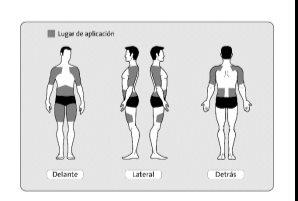 Apply the adhesive side of the patch to clean, dry, and healthy skin on the following areas, as indicated by the gray areas in the drawing:
Apply the adhesive side of the patch to clean, dry, and healthy skin on the following areas, as indicated by the gray areas in the drawing:
- Shoulder or upper arm.
- Abdomen.
- Sides (between the ribs and hips).
- Thigh or hip
To avoid skin irritation
|
|
If you continue to have skin problems caused by the patch, see “Skin problems caused by the patch” in section 4 for more information.
To prevent the patch from coming loose or falling off
- Do notapply the patch to an area where it may be rubbed by tight clothing.
- Do notuse creams, oils, lotions, powdersor any other skin productswhere you are going to apply the patch. Nor on top of or near another patch that you are already using.
- If you need to apply a patch to an area of skin where you have hair, you should shave(remove hair) the area of skin at least 3 days beforeapplying the patch to that site.
- If the edges of the patch come loose, you can secure the patch with a band-aid.
If the patch falls off, you should apply a new one for the rest of the day and the next day, apply a new patch at the usual time.
- You should avoidheating the patch area- for example, too much sunlight, saunas, hot baths, hot compresses or hot water bottles. This is because the medicine could be released more quickly. If you think you have overheated, contact your doctor or pharmacist.
- Always check that the patch has not fallen off after activities such as bathing, showering or exercising.
- If the patch has irritated your skin, you should keepthe irritated area protected from direct sunlight. This is because sun exposure could cause changes in skin color.
How to use the patch
- Each patch is packaged individually in a pouch.
- Before you open the pouch, decide where you are going to apply the new patch and check that you have removed the used patch.
- When you have opened the pouch and removed the disposable liner from the patch, apply the patch to your skin immediately.
|
|
|
|
|
|
Remove the protective liner from the top of the patch, beige in color, and discard it. A transparent protective liner (release liner) covers the adhesive side of the patch. |
|
|
|
|
|
Hold it pressed for about 30 seconds. This ensures that the patch is in contact with your skin and the edges adhere well. Wash your hands with water and soap immediately after handling the patch. |
|
How to remove the used patch
- Remove the used patch slowly and carefully.
- Gently wash the area with lukewarm water and a mild soap. This will remove any remaining adhesive from your skin. You can also use a little baby oil to remove any remaining adhesive.
- Do not use alcohol or other liquid solvents - such as nail varnish remover. This could irritate your skin.
If you use more Dariante than you should
Using higher doses of rotigotine than your doctor has told you may cause side effects such as nausea or vomiting, low blood pressure, seeing or hearing things that are not real (hallucinations), confusion, extreme sleepiness, involuntary movements and convulsions. In these cases, tell your doctor or go to the hospital as soon as possible. They will tell you what to do.
In case of overdose or accidental ingestion, consult your doctor or pharmacist immediately or call the Toxicology Information Service, telephone 91 562 04 20, indicating the medicine and the amount ingested.
If you forget to change the patch at the usual time
- If you have forgotten to change the patch at the usual time, change it as soon as you remember. Remove the used patch and apply a new one.
- If you have forgotten to apply a new patch after removing the used patch, apply a new one as soon as you remember.
In both cases, the next day, apply a new patch at the usual time. Do not use a double dose to make up for forgotten doses.
If you stop using Dariante
Do not stop using rotigotine without talking to your doctor first. Stopping treatment suddenly could cause you to have a condition called ‘neuroleptic malignant syndrome’ which can put your life at risk. The signs include: loss of muscle movement (akinesia), muscle stiffness, fever, unstable blood pressure, increased heart rate (tachycardia), confusion, decreased consciousness (e.g. coma).
If your doctor tells you to stop treatment with rotigotine, the daily doseof rotigotine should be gradually reduced:
- 1 mg every 2 days – if you are using rotigotine for Restless Legs Syndrome
If you have any other questions about the use of this medicine, ask your doctor or pharmacist.
4. Possible Adverse Effects
Like all medicines, this medicine can cause adverse effects, although not all people suffer from them. Inform your doctor, pharmacist, or nurse if you notice any adverse effect.
Most Likely Adverse Effects at the Start of Treatment
You may experience nauseaand vomitingat the start of treatment. These effects are usually mild or moderate and last for a short time. You should consult your doctorif the effects last for a long time or if you are concerned.
Skin Problems Caused by the Patch
- You may experience redness and itching in the skin area where the patch has been applied – these reactions are usually mild or moderate.
- These reactions usually disappear a few hours after removing the patch.
- Consult your doctorif you have a skin reaction that lasts for more than a few days, if it is severe, or if it spreads beyond the area covered by the patch.
- Avoid exposure to the sun and sunlamps in skin areas that show any type of reaction caused by the patch.
- To help prevent skin reactions, the patch should be placed on a different site each day, and the same area should only be used again after 14 days.
You May Suffer a Loss of Consciousness
Rotigotine can cause loss of consciousness. This can happen especially when starting treatment with rotigotine or when increasing the dose. Inform your doctor if you lose consciousness or feel dizzy.
Changes in Behavior and Abnormal Thoughts
Inform your doctor if you notice any change in behavior, thought, or both, as indicated below.
Your doctor will indicate how to manage or reduce the symptoms.
If your family or caregiver, or your doctor, are concerned about changes in your behavior, it may be helpful to tell a family member or caregiver that you are using this medicine and have them read the package insert. Rotigotine can cause anxiety or an overwhelming urge to behave abnormally and be unable to control the impulse, attack, or temptation to perform certain actions that may harm you or others – these symptoms are mainly observed in patients with Parkinson's disease.
These actions may include:
- strong addiction to gambling – even seriously affecting you or your family
- altered or increased sexual interest and behavior that causes great concern for you and others - for example, increased sexual desire
- uncontrolled shopping or excessive spending
- episodes of binge eating (eating large amounts of food in a short period) or compulsive eating (eating more food than normal or more than needed to satisfy your appetite)
Rotigotine can cause other abnormal behaviors and thoughts, which may include:
- abnormal thoughts about reality
- delusional ideas and hallucinations (seeing or hearing things that are not real)
- confusion
- disorientation
- aggressive behavior
- agitation
- delirium
Inform your doctor if you notice any change in your behavior, thought, or both, as indicated above.Your doctor will indicate how to manage or reduce the symptoms.
Allergic Reactions
Inform your doctor if you notice signs of an allergic reaction – which may include swelling of the face, tongue, or lips.
Adverse Effects if You Use Rotigotine for Parkinson's Disease
Inform your doctor, pharmacist, or nurse if you experience any of the following adverse effects:
Very Common: may affect more than 1 in 10 patients
- headache
- drowsiness or dizziness
- nausea, vomiting
- skin irritation at the patch application site, such as redness and itching
Common: may affect up to 1 in 10 patients
- falls
- hypo
- weight loss
- swelling in the legs and feet
- feeling of weakness (fatigue), feeling of tiredness
- increased heart rate (palpitations)
- constipation, dry mouth, heartburn
- redness, increased sweating, itching
- vertigo (feeling of spinning)
- seeing or hearing things that are not real (hallucinations)
- low blood pressure when standing up, high blood pressure
- difficulty staying asleep, sleep disorders, difficulty sleeping, nightmares, unusual dreams
- involuntary movements related to Parkinson's disease (dyskinesia)
- loss of consciousness, feeling of dizziness when standing up due to low blood pressure
- inability to control the impulse to perform a harmful action, including addiction to gambling, repetitive actions without sense, compulsive shopping or excessive spending
- episodes of binge eating (eating large amounts of food in a short period), compulsive eating (eating more food than normal or more than needed to satisfy your appetite)
Uncommon: may affect up to 1 in 100 patients
- blurred vision
- weight gain
- allergic reaction
- low blood pressure
- increased heart rate
- increased sexual desire
- abnormal heart rhythm
- stomach discomfort and pain
- generalized itching, skin irritation
- sudden sleepiness without warning
- inability to achieve or maintain an erection
- feeling agitated, disoriented, confused, or paranoid
- abnormal liver test results or elevated liver enzymes
- visual disturbances such as seeing colors or lights
- increased levels of creatine phosphokinase (CPK) (CPK is an enzyme found mainly in skeletal muscle)
Rare: may affect up to 1 in 1,000 patients
- delusional ideas
- delirium
- feeling of irritability
- aggressive behavior
- psychotic disorders
- rash on large areas of the body
- involuntary muscle spasms (convulsions)
Not Known: frequency not known
- anxiety due to taking high doses of medicines like rotigotine – more than necessary for the treatment of the disease. This is known as 'dopaminergic dysregulation syndrome' and can lead to excessive use of rotigotine
- diarrhea
- dropped head syndrome
- rhabdomyolysis (a rare, severe muscle disorder that causes pain, sensitivity, and weakness of the muscles and can lead to kidney problems)
Inform your doctor, pharmacist, or nurse if you experience any of these adverse effects.
Adverse Effects if You Use Dariante for Restless Legs Syndrome
Inform your doctor or pharmacist if you experience any of the following adverse effects:
Very Common: may affect more than 1 in 10 patients
- headache
- nausea
- feeling of weakness (fatigue)
- skin irritation at the patch application site, such as redness and itching
Common: may affect up to 1 in 10 patients
- itching
- feeling of irritability
- allergic reaction
- increased sexual desire
- increased blood pressure
- vomiting, heartburn
- swelling in the legs and feet
- drowsiness, sudden sleepiness without warning, difficulty sleeping, sleep problems, unusual dreams
- inability to control the impulse to perform a harmful action, including addiction to gambling, repetitive actions without sense, compulsive shopping or excessive spending
- episodes of binge eating (eating large amounts of food in a short period), compulsive eating (eating more food than normal or more than needed to satisfy your appetite)
Uncommon: may affect up to 1 in 100 patients
- feeling agitated
- feeling of dizziness when standing up due to low blood pressure
Rare: may affect up to 1 in 1,000 patients
- aggressive behavior
- disorientation
Not Known: frequency not known
- anxiety due to taking high doses of medicines like rotigotine – more than necessary for the treatment of the disease. This is known as 'dopaminergic dysregulation syndrome' and can lead to excessive use of rotigotine
- seeing or hearing things that are not real (hallucinations)
- nightmares
- paranoia
- confusion
- psychotic disorders
- delusional ideas
- delirium
- dizziness
- loss of consciousness, involuntary movements (dyskinesia)
- involuntary muscle spasms (convulsions)
- blurred vision
- visual disturbances such as seeing colors or lights
- vertigo (feeling of spinning)
- increased heart rate (palpitations)
- abnormal heart rhythm
- low blood pressure
- hypo
- constipation, dry mouth
- stomach discomfort and pain
- diarrhea
- redness, increased sweating
- generalized itching, skin irritation
- generalized rash
- inability to achieve or maintain an erection
- weight loss, weight gain
- abnormal liver test results or elevated liver enzymes
- increased heart rate
- increased levels of creatine phosphokinase (CPK) (CPK is an enzyme found mainly in skeletal muscle)
- falls
- rhabdomyolysis (a rare, severe muscle disorder that causes pain, sensitivity, and weakness of the muscles and can lead to kidney problems)
Inform your doctor or pharmacist if you experience any of these adverse effects.
Reporting Adverse Effects
If you experience any type of adverse effect, consult your doctor or pharmacist, even if it is a possible adverse effect that is not listed in this package insert. You can also report them directly through the Spanish Pharmacovigilance System for Human Use Medicines (www.notificaram.es). By reporting adverse effects, you can contribute to providing more information on the safety of this medicine.
5. Storage of Dariante
Keep this medicine out of the sight and reach of children.
Do not use this medicine after the expiration date stated on the packaging and on the blister pack after "EXP". The expiration date is the last day of the month indicated.
This medicine does not require special storage conditions.
What to Do with Used and Unused Patches
- Used patches still contain the active ingredient, 'rotigotine', which can be hazardous to others. Fold the used patch with the adhesive side facing inward. Place the patch in the original blister pack and then throw it away in a safe place, out of the reach of children.
- Medicines should not be disposed of via wastewater or household waste. Deposit the packaging and medicines that you no longer need at the Sigre collection point. Ask your pharmacist how to dispose of the packaging and medicines that you no longer need. This will help protect the environment.
6. Package Contents and Additional Information
Composition of Dariante
The active ingredient is rotigotine.
- One patch releases 2 mg of rotigotine every 24 hours. Each 9.2 cm2 patch contains 3.68 mg of rotigotine.
The other ingredients are:
- Backing layer: pigmented polyethylene, aluminum vapor-coated polyester, orange printing ink.
- Matrix layer, which contains the active substance: tocopherol, paraffin, povidone K90, silicone adhesive.
- Release liner: fluorosilicone-coated polyester film.
- Covering layer: fluorosilicone-coated polyester film.
Appearance of the Product and Package Contents
Dariante is a transdermal patch. It is thin, square in shape with rounded corners. The outer part is brown in color and bears the imprint "Rotigotine 2 mg/24 h".
Dariante is available in the following formats:
Packages containing 7, 14, 28, 30, or 84 (multiple package containing 3 packages of 28) patches, each patch is included in an individual blister pack.
Not all pack sizes may be marketed.
Marketing Authorization Holder and Manufacturer
Marketing Authorization Holder
Exeltis Healthcare, S.L.
Avenida de Miralcampo, 7
Polígono Industrial Miralcampo
19200 Azuqueca de Henares.
Guadalajara, Spain
Manufacturer
Luye Pharma AG
Am Windfeld 35
83714 Miesbach
Germany
This medicine is authorized in the Member States of the European Economic Area under the following names:
Germany: Rotigotin Luye 2 mg/24 Stunden Transdermales Pflaster
Spain: Dariante 2 mg/24 h transdermal patches EFG
Italy: Rotigotina Luye 2 mg/ore cerotto transdermico
Date of the Last Revision of this Package Insert:March 2024
Other Sources of Information
Detailed information on this medicine is available on the website of the Spanish Agency for Medicines and Health Products (AEMPS) (http://www.aemps.gob.es/).

How much does DARIANTE 2 mg/24 hours TRANSDERMAL PATCHES cost in Spain ( 2025)?
The average price of DARIANTE 2 mg/24 hours TRANSDERMAL PATCHES in October, 2025 is around 37.47 EUR. Prices may vary depending on the region, pharmacy, and whether a prescription is required. Always check with a local pharmacy or online source for the most accurate information.
- Country of registration
- Average pharmacy price37.47 EUR
- Active substance
- Prescription requiredYes
- Manufacturer
- This information is for reference only and does not constitute medical advice. Always consult a licensed doctor before taking any medication. Oladoctor is not responsible for medical decisions based on this content.
- Alternatives to DARIANTE 2 mg/24 hours TRANSDERMAL PATCHESDosage form: TRANSDERMAL PATCH, 1 mg/24 hActive substance: rotigotineManufacturer: Exeltis Healthcare S.L.Prescription requiredDosage form: TRANSDERMAL PATCH, 3 mg/24 hActive substance: rotigotineManufacturer: Exeltis Healthcare S.L.Prescription requiredDosage form: TRANSDERMAL PATCH, 4 mg/24 hActive substance: rotigotineManufacturer: Exeltis Healthcare S.L.Prescription required


